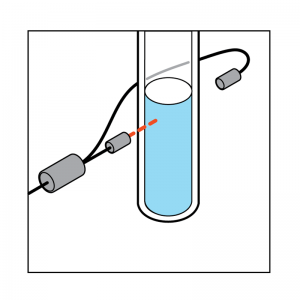In some industries such as life sciences it is necessary to detect clear water or clear liquids in a container or tube. This is even more challenging when the diameters of the tube are small, and the tube thickness is nearly as large as the stream of liquid.
The attenuation or gradual reduction of the intensity of the light beam in water and air can be directly compared. The attenuation of light in water can be attributed to light entering water at any angle other than at a right angle and can be refracted. The measurement of light through a tube is different because not only is the light attenuated by the liquid, but depending on where the light passes through the tube it can be refracted, diverted and or focused. As a result, the signal differences can be low.
Attenuation is typically the first choice if the liquids are opaque or colored. The requirements of the shape of the light beam and the alignment of the sensor add more complication to the application. The attenuation effect appears weaker in clear liquids. The principle does not work with reflective sensors since reflection is a surface effect and the light must pass through the liquid.
From spectral analysis it’s has been determined that the attenuation characteristics of water are heavily dependent on the wavelength of the light that is conducted through it. Sensors were developed for such applications. Typically, these sensors utilize LED’s in the upper infrared range of 1,450 nm. At this wavelength water literally absorbs the light and becomes opaque making detection more simplified and reliable.
This principle even works for fine capillaries and microchannels. Liquid detection can be very precise depending on the sensor size and the effective light beam. Light beams as small as 0.4mm can provide high resolution for small thin tubes typically found in microfluidics applications.
Versions of these sensors exist for applications that involve less transparent or semi-transparent vessels. Light at the 1450nm wavelength can pass through these containers or tubes and can be attenuated by the water. The main factor is that enough light makes its way through the walls of the container.
Through-beam sensors were developed for applications such as detecting clear liquids. These sensors are also available in extremely small dimensions and usually require an amplifier, or they can be supplied in a rugged fork sensor housing. The required sensor dimensions conform to the geometry of the vessel or container.
For more information on sensors for these types of applications contact your local Balluff representative or contact us at www.balluff.com.


3 Replies to “Make Clear Water Visible to Your Sensors”